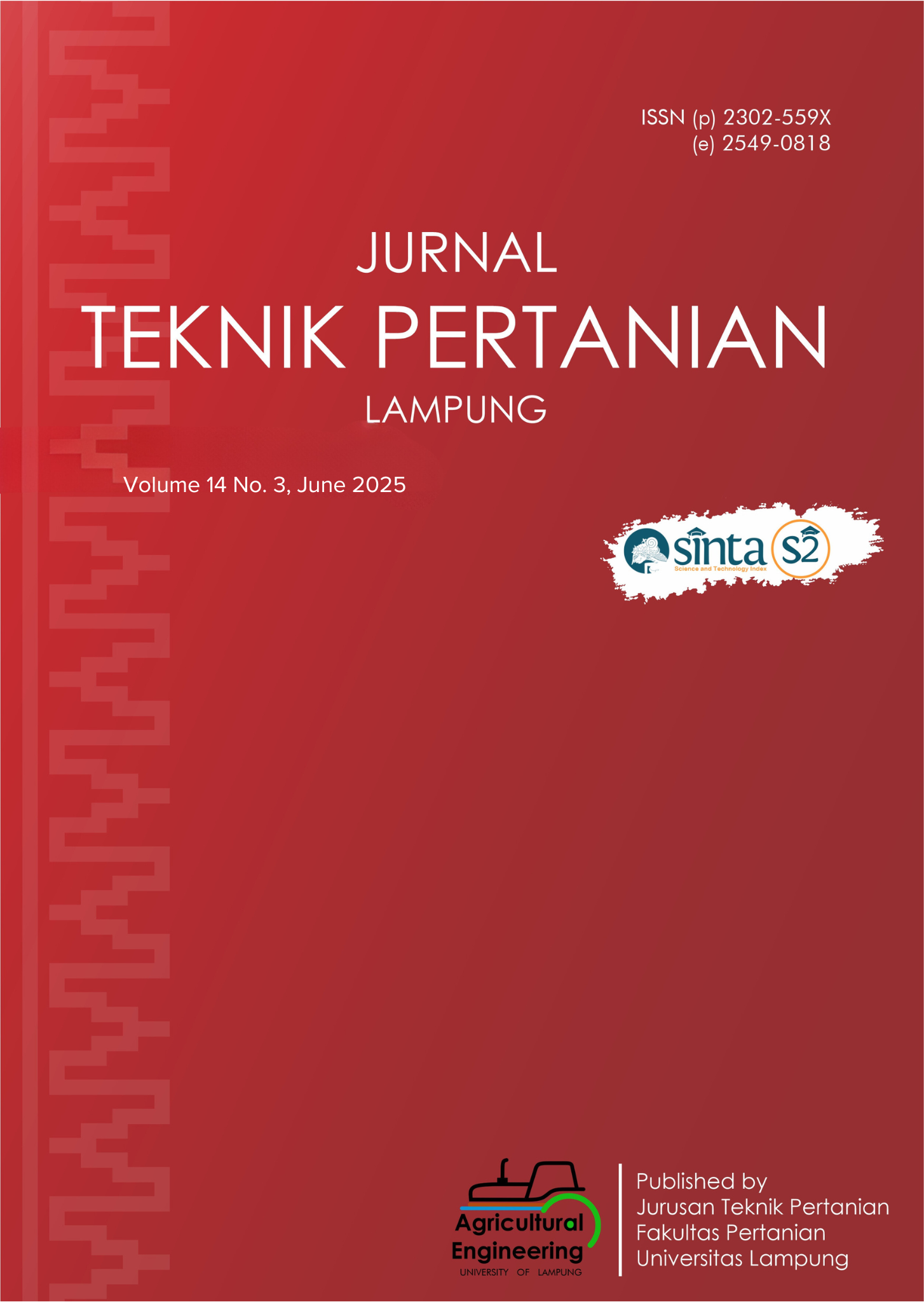Performance Test of Sieving Machine and Physical Characteristics of Corn Grits Production
DOI:
https://doi.org/10.23960/jtep-l.v14i3.803-811 Abstract View: 185
Abstract View: 185
Abstract
Corn grits can be used as a substitute for rice as a staple food. This is based on the nutritional content of corn grits and also rice is a food ingredient that is dense in energy in its processing. Sieving is an important operating unit in addition to size reduction and cleaning which is intended to obtain a certain particle size in the manufacture of corn grits. The use of a sieving machine in selecting the size of corn grits determines the quality of the product. The size of corn grits also determines the level of public preference. The purpose of this study was to analyze the performance of the sieving machine and the physical quality characteristics of the resulting corn grits. The treatment variables of the study included the machine rotation speed (A) of 240, 320, 520 RPM and the sieving duration (B) of 10, 15, 20 minutes. Data analysis used ANOVA and DMRT Test. The combination of treatments (machine rotation speed and sieving duration) gave a significant difference to the sieving capacity. The treatment of rotation speed of 520 RPM and sieving duration of 20 minutes gave the largest sieving capacity of 94.66 kg/hour, sieving yield of 90%; water content of 13%, angle of repose of 0,62 radian (35,54ᵒ), and size distribution (D) of 1.78 mm.
Keywords: Corn grits, Duration, Sieving performance, Physical characteristics, Rotation speed.
Downloads
References
Abdulrahaman, A.A., & Kolawole, O.M. (2006). Traditional preparations and uses of maize in Nigeria. Ethnobotanical Leaflets, 10(17), 219–227. http://www.ethnoleaflets.com/leaflets/kolawole.htm
Adedokun, S.O., Jimoh, K.O., Azeez, L.A., Adeoti, O.A, & Babalola, J.O. (2023). Effect of steam parboiling time on corn grits (Zea mays) drying time, proximate, minerals and functional properties with differently cooked meal (“Egbo”) re-cooking time and acceptability. Journal of Human Nutrition & Food Science, 11(5), 1175.
Elleuch, M., Bedigian, D., Roiseux, O., Besbes, S., Blecker, C., & Attia, H. (2011). Dietary fibre and fibre-rich by-products of food processing: Characterisation, technological functionality and commercial applications: A review. Food Chemistry, 124(2), 411 421. https://doi.org/10.1016/j.foodchem.2010.06.077
Giacco, R., Clemente, G., & Riccardi, G. (2002). Dietary fibre in treatment of diabetes: Myth or reality? Digestive and Liver Disease, 34, S140–S144. https://doi.org/10.1016/S1590-8658(02)80182-7
Aryunis, A., & Tafzi, F. (2017). Identifikasi karakteristik beras dan mutu tanak nasi padi ladang lokal asal Jambi. Prosiding Seminar Nasional dan Rapat Tahunan Dekan, Bidang Ilmu Pertanian BKS-PTN Wilayah Barat Bidang Pertanian. Fakultas Pertanian, Perikanan, dan Biologi Universitas Bangka Belitung: 408-414
Djaina, R.Y. (2017). Analisa Kandungan Proksimat dan Kalsium Grits Jagung Nikstamal Sebagai Bahan Baku Bubur Tradisional Gorontalo. [Undergraduate Theses]. Department of Food Science and Technology, University of Gorontalo.
Hudji, R., Ahmad, L., & Antuli, Z. (2019). Analisis umur simpan grits bubur jagung instan nikstamal berdasarkan kadar air kritis dan kondisi organoleptiknya. Jambura Journal of Food Technology, 1(1), 68–78.
Kharisma, N., Waluyo, S., & Tamrin. 2014. Pengaruh perbedaan putar (RPM) discmill terhadap keseragaman ukuran butiran gula semut. Jurnal Teknik Pertanian Lampung, 3(3), 223-232.
Kumalasari, R., Setyoningrum, F., & Ekafitri, R.E. (2015). Karakteristik fisik dan sifat fungsional beras jagung instan akibat penambahan jenis serat dan lama pembekuan. Jurnal Pangan, 24(1), 37–48.
Lalujan, L.E., Djarkasi, G.S.S., Tuju, T.J.N., Rawung, D., & Sumual, M.F. (2017). Komposisi kimia dan gizi jagung lokal varietas “Manado Kuning” sebagai bahan pangan pengganti beras. Jurnal Teknologi Pertanian, 8(1), 47-54.
Mahmud, N.V., Une, S., & Maspeke, P.N. (2024). Analisis perbandingan kualitas fisik dan organoleptik grits jagung dan grits bubur jagung instan terfortifikasi ekstrak daun kersen. Jambura Journal of Food Technology, 6(2), 199-213.
Medho, M.S., & Mohamad, E.V. (2024). Characteristics of modified timor white corn flour and its cookies enriched with moringa leaves. Jurnal Teknik Pertanian Lampung, 13(2), 581-591. http://dx.doi.org/10.23960/jtep-l.v13i2.581-591
Mulyawan, P.D., Iqbal, I., & Munir, A. (2018). Uji kinerja mesin pemecah kulit gabah (husker) tipe rol karet pada penggilingan gabah kecil. Jurnal AgriTechno, 11(1). https://doi.org/10.20956/at.v11i1.86
Rahmana, I., Mucra, D.A., & Febrina, D. (2016). Kualitas fisik pelet ayam broiler periode akhir dengan penambahan feses ternak dan bahan perekat yang berbeda. Jurnal Peternakan, 13(1). http://dx.doi.org/10.24014/jupet.v13i1.2387
Sanchez-Suarez, N., Orozco-Mendoza, G. L., Zartha-Sossa, J. W., Gafaro-Garcés, D. C., Melchor-Cahuana, L. G., & Gonzalez Tovar, C. (2022). Trends in Sieving and Its Applications in Cereals. A Literature Review. Frontiers in Sustainable Food Systems, 6(July), 1–14. https://doi.org/10.3389/fsufs.2022.902147
Sandhu, K. S., Singh, N., & Malhi, N. S. (2007). Some properties of corn grains and their flours I: Physicochemical, functional and chapati-making properties of flours. Food Chemistry, 101(3), 938–946. https://doi.org/10.1016/j.foodchem.2006.02.040
Sofiana, D. (2019). Kajian Lama Pengukusan Beras Jagung Terhadap Karakteristik Sifat Fisik dan Kimia Nasi Jagung Instan. [Undergraduate Theses]. Department of Agricultural Product Technology, Faculty of Agricultural Technology, Universitas Semarang.
Suprobo, G., & Rahmi, D. (2015). Pengaruh kecepatan homegenisasi terhadap sifat fisika dan kimia krim nanopartikel dengan metode high speed homogenization (HSH). Jurnal Riset Industri, 5(1), 1-12.
Utami, A. (2018). Uji Kinerja Mesin Penepung Tipe Hammer Mill Untuk Penepung Singkong (Manihot Esculenta). [Undergraduate Theses]. Jurusan Keteknikan Pertanian, Universitas Brawijaya, Malang.
Walalangi, O., Ahmad, L., & Une, S. (2020). Analisis karakteristik komponen kimia dan organoleptik grits bubur jagung terfortifikasi ekstrak daun kersen (Muntingia calabura L.). Jambura Journal of Food Technology, 2(1), 13–27.
Wu, Y., Zhou, G., Song, X., Song, Y., Ren, S., Geng, J., & Zhao, H. (2024). Key Stage and Its Optimum Meteorological Conditions Affecting the Nutritional Quality of Maize. Agronomy, 14(3). https://doi.org/10.3390/agronomy14030420
Wukirsari, T., Saepudin, E., & Hanafiah, P.I. (2022). Physicochemical properties of resistant starch from acid hydrolysis and heat moisture treatment of corn starch. Jurnal Agritechno, 15(1). https://doi.org/10.20956/at.v15i1.587
Downloads
Published
How to Cite
Issue
Section
License
Authors who publish with this journal agree to the following terms:
Authors retain copyright and grant the journal right of first publication with the work simultaneously licensed under a Creative Commons Attribution-ShareAlike 4.0 International Lice that allows others to share the work with an acknowledgement of the work's authorship and initial publication in this journal.
Authors are able to enter into separate, additional contractual arrangements for the non-exclusive distribution of the journal's published version of the work (e.g., post it to an institutional repository or publish it in a book), with an acknowledgement of its initial publication in this journal.
Authors are permitted and encouraged to post their work online (e.g., in institutional repositories or on their website) prior to and during the submission process, as it can lead to productive exchanges, as well as earlier and greater citation of published work (See The Effect of Open Access).
Jurnal Teknik Pertanian Lampung

JTEPL is licensed under a Creative Commons Attribution-ShareAlike 4.0 International License.













